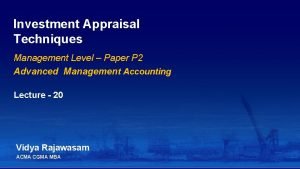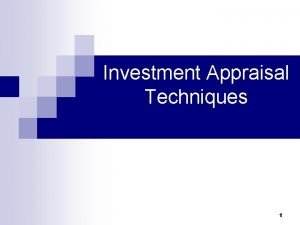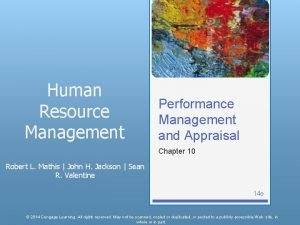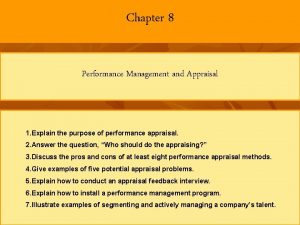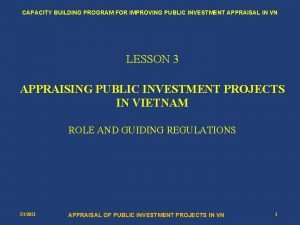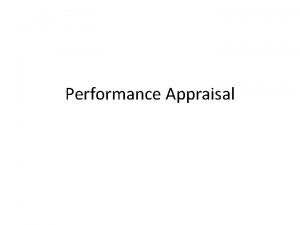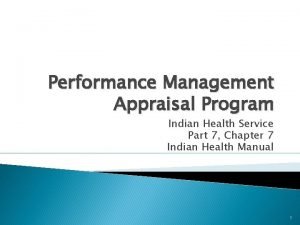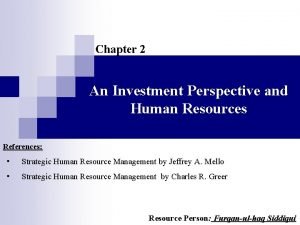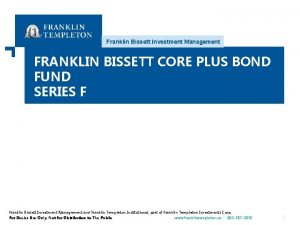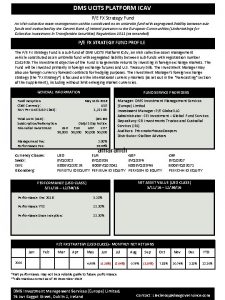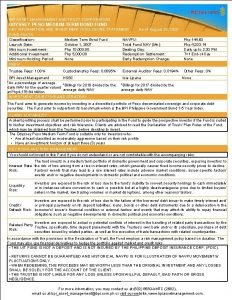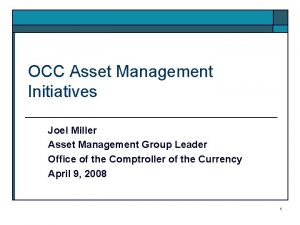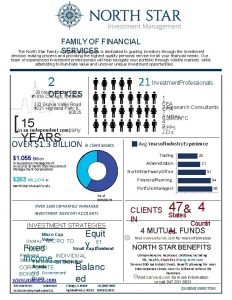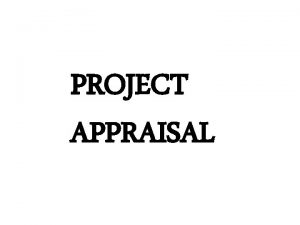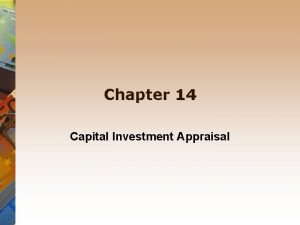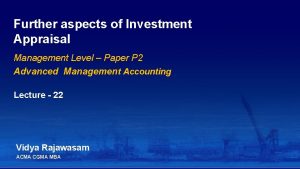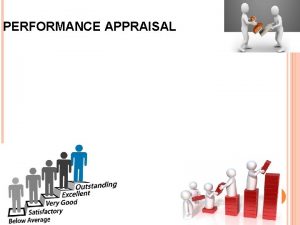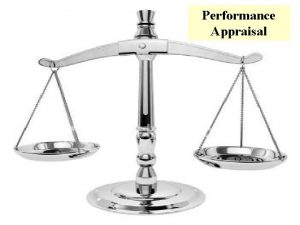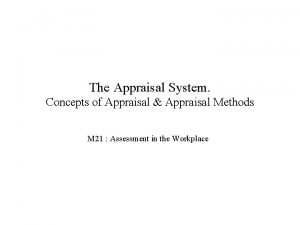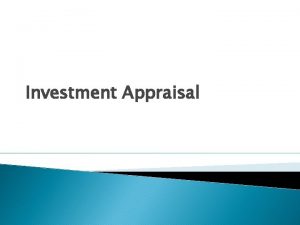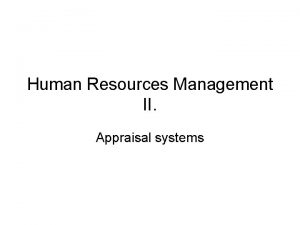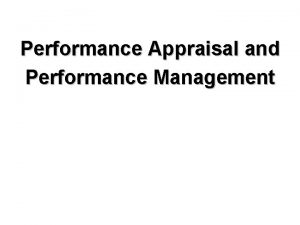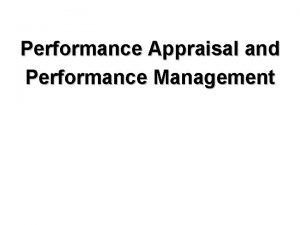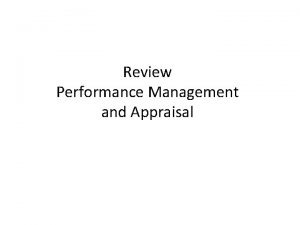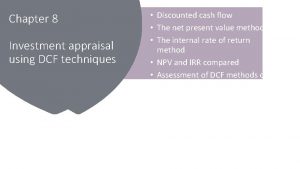Investment Appraisal Techniques Management Level Paper P 2













































- Slides: 45

Investment Appraisal Techniques Management Level – Paper P 2 Advanced Management Accounting Lecture - 21 Vidya Rajawasam ACMA CGMA MBA

Investment Appraisal Techniques In the previous lectures we have discussed § § § The time value of money Compound interest Discounting Capital investment appraisal Net Present Value (NPV)

Investment Appraisal Techniques In this lecture we will discuss § Examples of annuities § Internal Rate Return (IRR)

Investment Appraisal Techniques Examples of annuities Advanced and delayed annuities and perpetuities The use of annuity factors and perpetuity factors both assume that the first cash flow will be occurring in one year's time. Annuity or perpetuity factors will therefore discount the cash flows back to give the value one year before the first cash flow arose

Investment Appraisal Techniques Examples of annuities Advanced and delayed annuities and perpetuities For standard annuities and perpetuities this gives the present (T 0) value since the first cash flow started at T 1. Be careful: if this is not the case, you will need to adjust your calculation.

Investment Appraisal Techniques Examples of annuities Advanced and delayed annuities and perpetuities In some investment appraisals, regular cash flows may start now (at T 0) rather than in one year's time (T 1). Calculate the PV by ignoring the payment at T 0 when considering the number of cash flows and then adding one to the annuity or perpetuity factor.

Investment Appraisal Techniques Examples of annuities Example using advanced annuities A 5 -year $600 annuity is starting today. Interest rates are 10%. Find the PV of the annuity.

Investment Appraisal Techniques Examples of annuities Solution This is essentially a standard 4 -year annuity with an additional payment at T 0. The PV could be calculated as follows:

Investment Appraisal Techniques Examples of annuities Solution This is essentially a standard 4 -year annuity with an additional payment at T 0. The PV could be calculated as follows:

Investment Appraisal Techniques Examples of annuities Solution PV = 600 + 600 × 3. 17 = 600 + 1902 = $2, 502 The same answer can be found more quickly by adding 1 to the AF: PV = 600 × (1 + 3. 17) = 600 × 4. 17 = $2, 502.

Investment Appraisal Techniques Examples of annuities Requirement A perpetuity of $2, 000 is due to commence immediately. The interest rate is 9%. What is the PV?

Investment Appraisal Techniques Examples of annuities Solution This is essentially a standard perpetuity with an additional payment at T 0. The PV could be calculated as follows: T 0 $ 2000 T 1 $2000 T 2 T 3 T 4 ……….

Investment Appraisal Techniques Examples of annuities Solution Again, the same answer can be found more quickly by adding 1 to the perpetuity factor. T 0 $ 2000 T 1 $2000 T 2 T 3 T 4 ……….

Investment Appraisal Techniques Examples of annuities Delayed annuities and perpetuities Some regular cash flows may start later than T 1. These are dealt with by: (1)applying the appropriate factor to the cash flow as normal (2)discounting your answer back to T 0.

Investment Appraisal Techniques Example of delayed annuities For delayed cash flows, applying the standard annuity factor will find the value of the cash flows one year before they began, which in this illustration is T 2. To find the PV, an additional calculation is required the value must be discounted back to T 0.

Investment Appraisal Techniques Example of delayed annuities What is the PV of $200 incurred each year four years, starting in three year's time, if the discount rate is 5%?

Investment Appraisal Techniques Example of delayed annuities Solution

Investment Appraisal Techniques Example of delayed annuities Solution

Investment Appraisal Techniques Review MCQs What is an annuity ? a. Positive cash flows from bank deposits. b. Non Regular Positive cash flows from investments. c. A fixed sum of money paid to someone each year, typically for the rest of their life. d. Non of the above

Investment Appraisal Techniques Review MCQs What is an annuity ? a. Positive cash flows from bank deposits. b. Non Regular Positive cash flows from investments. c. A fixed sum of money paid to someone each year, typically for the rest of their life. d. Non of the above

Investment Appraisal Techniques Review MCQs What is the true statement with regard to annuity and perpetuity ? a. Perpetuity is a type of annuity which continues forever. b. For annuity payments may last only for less than 10 years. c. Perpetuity payments only last for less than 20 years. d. Non of the above.

Investment Appraisal Techniques Review MCQs What is the true statement with regard to annuity and perpetuity ? a. Perpetuity is a type of annuity which continues forever. b. For annuity payments may last only for less than 10 years. c. Perpetuity payments only last for less than 20 years. d. Non of the above.

Investment Appraisal Techniques Internal Rate of Return The IRR is another project appraisal method using DCF techniques. The IRR represents the discount rate at which the NPV of an investment is zero. As such it represents a breakeven cost of capital.

Investment Appraisal Techniques Internal Rate of Return Calculating the IRR using linear interpolation The steps in linear interpolation are: (1)Calculate two NPVs for the project at two different costs of capital (2)Use the formula to find the IRR:

Investment Appraisal Techniques Internal Rate of Return IRR Formula; L = Lower rate of interest H = Higher rate of interest NL = NPV at lower rate of interest NH = NPV at higher rate of interest

Investment Appraisal Techniques Internal Rate of Return The diagram below shows the IRR as estimated by the formula.

Investment Appraisal Techniques Internal Rate of Return The decision rule; A project/s should be accepted if their IRR is greater than the cost of capital. Examples using IRR A potential project's predicted cash flows give a NPV of $50, 000 at a discount rate of 10% and an NPV of $10, 000 at a rate of 15%.

Investment Appraisal Techniques Examples using IRR Solution The IRR = 14. 17%

Investment Appraisal Techniques The Advantages and disadvantages of IRR Advantages The IRR has a number of benefits, § The Calculation considers the time value of money § The calculation is a percentage and therefore easily understood § The calculation uses cash flows not profits.

Investment Appraisal Techniques The Advantages and disadvantages of IRR Advantages The IRR has a number of benefits, § The calculation considers the whole life of the project. § Therefore, a firm selecting projects where the IRR exceeds the cost of capital should increase shareholders' wealth. .

Investment Appraisal Techniques The Advantages and disadvantages of IRR Disadvantages The IRR has a number of drawbacks, § It is not a measure of absolute profitability. § Interpolation only provides an estimate and an accurate estimate requires the use of a spreadsheet program.

Investment Appraisal Techniques The Advantages and disadvantages of IRR Disadvantages The IRR has a number of drawbacks, § It is fairly complicated to calculate. § Non-conventional cash flows may give rise to multiple IRRs which means the interpolation method can't be used

Investment Appraisal Techniques Difficulties with the IRR approach Interpolation only provides an estimate (and an accurate estimate requires the use of a spreadsheet program). The cost of capital calculation itself is also only an estimate and if the margin between required return and the IRR is small, this lack of accuracy could actually mean the wrong decision is taken.

Investment Appraisal Techniques Difficulties with the IRR approach Another drawback of IRR is that nonconventional cash flows may give rise to no IRR or multiple IRRs. Example, a project with an outflow at T 0 and T 2 but income at T 1 could, depending on the size of the cash flows, have a number of different profiles on a graph. Even where the project does have one IRR, the graph indicates that the decision rule would lead to the wrong result as the project does not earn a positive NPV at any cost of capital.

Investment Appraisal Techniques Difficulties with the IRR approach

Investment Appraisal Techniques NPV versus IRR Both NPV and IRR are investment appraisal techniques which discount cash flows and are superior to the basic techniques such as ROCE or payback. However only NPV can be used to distinguish between two mutually-exclusive projects, as the diagram demonstrates:

Investment Appraisal Techniques NPV versus IRR

Investment Appraisal Techniques NPV versus IRR The profile of project A is such that it has a lower IRR and applying the IRR rule would prefer project B. However in absolute terms, A has the higher NPV at the company's cost of capital and should therefore be preferred. NPV is therefore the better technique for choosing between projects.

Investment Appraisal Techniques NPV versus IRR The advantage of NPV is that it tells us the absolute increase in shareholder wealth as a result of accepting the project, at the current cost of capital. The IRR simply tells us how far the cost of capital could increase before the project would not be worth accepting. The modified internal rate of return (MIRR) solves many of these problems with the conventional IRR.

Investment Appraisal Techniques Review MCQs The advantages of using IRR ? a. The calculation is a percentage and therefore it is easy to understand. b. Identifies the activities and costs related to internal processors c. Provides understanding related to External supplier relationships d. Non of the above.

Investment Appraisal Techniques Review MCQs The advantages of using IRR ? a. The calculation is a percentage and therefore it is easy to understand. b. Identifies the activities and costs related to internal processors c. Provides understanding related to External supplier relationships d. Non of the above.

Investment Appraisal Techniques Review MCQs The disadvantages of IRR? a. b. c. d. Easy to understand Very difficult to implement Complicated to calculate Non of the above

Investment Appraisal Techniques Review MCQs The disadvantages of IRR? a. b. c. d. Easy to understand Very difficult to implement Complicated to calculate Non of the above

Investment Appraisal Techniques Lecture Summary We have discussed the § Examples of annuities § Internal Rate Return (IRR)

Investment Appraisal Techniques Management Level – Paper P 2 Advanced Management Accounting Lecture - 21 Vidya Rajawasam ACMA CGMA MBA
 Investment appraisal examples
Investment appraisal examples Investment appraisal techniques
Investment appraisal techniques Pvci appraisal
Pvci appraisal Fixed investment and inventory investment
Fixed investment and inventory investment Performance appraisal important
Performance appraisal important Mbo performance appraisal method
Mbo performance appraisal method Management fifteenth edition
Management fifteenth edition Chapter 8 performance management and appraisal
Chapter 8 performance management and appraisal Performance management vs performance appraisal
Performance management vs performance appraisal Behaviorally anchored rating scale
Behaviorally anchored rating scale Project appraisal and management
Project appraisal and management Performance management and appraisal chapter 8
Performance management and appraisal chapter 8 Rims appraisal management
Rims appraisal management Objectives of performance appraisal
Objectives of performance appraisal Pmap ratings
Pmap ratings Employee development
Employee development Aice english paper 2
Aice english paper 2 Aice general paper exam
Aice general paper exam Fonction technique scooter
Fonction technique scooter Worksheet 2 searching algorithms answers
Worksheet 2 searching algorithms answers Preparation definition geography
Preparation definition geography Edexcel past papers english literature
Edexcel past papers english literature Memory psychology a level
Memory psychology a level Aqa a level chemistry paper 1 2020
Aqa a level chemistry paper 1 2020 Practical investment management
Practical investment management Mba investment management concentration
Mba investment management concentration Investment perspective of human resource management
Investment perspective of human resource management Investment perspective of human resource management
Investment perspective of human resource management Portfolio management steps
Portfolio management steps Investment management segment
Investment management segment Investment analysis and portfolio management notes for mba
Investment analysis and portfolio management notes for mba Bissett investment management
Bissett investment management Strategie consulting dms
Strategie consulting dms Navpu bpi
Navpu bpi Common errors in investment management
Common errors in investment management Scope of investment analysis and portfolio management
Scope of investment analysis and portfolio management Investment analysis & portfolio management
Investment analysis & portfolio management Investment analysis and portfolio management course
Investment analysis and portfolio management course Korea investment management
Korea investment management Occ investment management handbook
Occ investment management handbook Key risk indicators for vendor management
Key risk indicators for vendor management Franklin bissett canadian equity
Franklin bissett canadian equity Fiduciary investment risk management association
Fiduciary investment risk management association North star investment management corporation
North star investment management corporation The investment function in financial services management
The investment function in financial services management Molecular level vs cellular level
Molecular level vs cellular level
